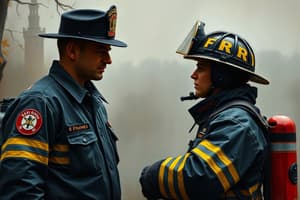Podcast
Questions and Answers
What is a common cause of firefighter deaths?
What is a common cause of firefighter deaths?
- Asphyxiation (correct)
- Burns
- Trauma
- Heart attacks
What technology can monitor air consumption and notify when low air alarms are activated?
What technology can monitor air consumption and notify when low air alarms are activated?
- GPS
- Thermal imaging cameras
- Radio
- Computer-based systems (correct)
What incident demonstrated the importance of pre-incident planning?
What incident demonstrated the importance of pre-incident planning?
- West Fertilizer explosion in Texas in 2013 (correct)
- Hurricane Katrina
- Worcester, Massachusetts warehouse fire
- 9/11 terrorist attacks
Who has responsibilities to provide procedures, training, equipment, and supervise members for safety?
Who has responsibilities to provide procedures, training, equipment, and supervise members for safety?
What principles should be applied to fire-ground operations?
What principles should be applied to fire-ground operations?
What is the first statement in NFPA 1500-8.4.2.1(1)?
What is the first statement in NFPA 1500-8.4.2.1(1)?
What is flashover?
What is flashover?
What can affect the time to flashover?
What can affect the time to flashover?
What is the building's fuel load made up of?
What is the building's fuel load made up of?
What has increased the fuel load and reduced the time to flashover in residential buildings?
What has increased the fuel load and reduced the time to flashover in residential buildings?
What is the two-in/two-out rule?
What is the two-in/two-out rule?
What is the decision to employ a defensive approach based on?
What is the decision to employ a defensive approach based on?
Flashcards are hidden until you start studying
Study Notes
- Figures 5-4 to 5-7 show firefighter deaths by type of duty, cause of injury, nature of injury, and nature of injury in structure fires only from 2009 to 2018.
- Asphyxiation is a common cause of firefighter deaths, and air management is crucial to prevent depletion of SCBA air supply.
- Technology such as computer-based systems can monitor air consumption and notify when low air alarms are activated.
- Pre-incident planning is essential to prevent fatalities, as demonstrated by the West Fertilizer explosion in Texas in 2013 that killed 10 firefighters and two civilians.
- Near misses and minor injuries should be reported as they can indicate common hazards and merit examination.
- Fire administrators, ICs, and company officers have responsibilities to provide procedures, training, equipment, and supervise members for safety.
- Risk management principles should be applied to fire-ground operations, as outlined in NFPA 1500.
- The decision to employ a defensive approach based on risks outweighing benefits can be difficult, as illustrated by the Worcester, Massachusetts, warehouse fire where six firefighters perished.
- The first statement in NFPA 1500-8.4.2.1(1) limits significant risk activities to situations where there is a potential to save endangered lives.
- The ability to recognize the point at which the risk to firefighters' lives outweighs the possible benefits of saving lives and property is crucial for fire officers.
- The two-in/two-out rule is controversial in firefighting.
- There are exceptions to the rule in cases of imminent life-threatening situations.
- Probability is important in evaluating risk vs. benefit.
- Time, occupancy, fire intensity, and building construction affect the probability of saving lives.
- Flashover is a dangerous transition in a growing fire.
- Ventilation can affect the time to flashover.
- Wind can increase fire intensity and smoke movement.
- The building's fuel load is made up of contents and combustible building materials.
- Modern furnishings have increased the fuel load and reduced the time to flashover in residential buildings.
- Fire departments must adjust their tactics based on these factors.
Studying That Suits You
Use AI to generate personalized quizzes and flashcards to suit your learning preferences.




